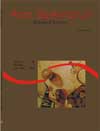<b>The use of “<em>branchoneta</em>” <em>Dendrocephalus brasiliensis</em> (Pesta 1921) nauplii in <em>Litopenaeus vannamei</em> (Boone 1931) larval feeding</b> - DOI: 10.4025/actascibiolsci.v25i2.2013
Abstract
The aim of this study was to evaluate the performance of Dendrocephalus brasiliensis as food for Litopenaeus vannamei larvae and post-larvae. The larvae (Protozoea PZ3) were stocked in 15 buckets (filled up with 10 liters of water), at a density of 100 larvae/L and they were grown during 18 days until post-larvae (PL10). The experiment consisted of 5 feeding treatments and 3 repetitions: 1 (T1), live Artemia sp. nauplii; 2 (T2), live D. brasiliensis nauplii; 3 (T3), frozen D. brasiliensis; 4 (T4), a combination of live Artemia sp. nauplii and live D. brasiliensis nauplii; 5 (T5), a combination of live Artemia sp. nauplii and frozen D. brasiliensis nauplii; micro-algae were offered for all of them. The larvae were fed 8 times a day; during the first 2 days they were given 800 D. brasiliensis nauplii/L/day; from the 3rd until the 6th day they were given 2000 D. brasiliensis nauplii/L/day and from the 7th day until the final, 4000 D. brasiliensis nauplii/L/day. The larvae were completed the metamorphosis to post-larvae (PL1) in 169, 168, 170, 171 and 169 hours for T1, T2, T3, T4 and T5, respectively. The mean weight and length at (PL1) stage were, 444.444µg and 6mm for T1, 592.59µg and 5.866mm for T2, 224.082µg and 5.733mm for T3, 448.838µg and 5.6mm for T4 and 290.474µg and 5.866mm for T5, respectively. The experiment was finished at the PL10 stage when the post-larvae were counted to determine the survival rate. The survival results showed: 58.8%; 35.5%; 36.6%; 76.3% and 79.3% for T1, T2, T3, T4, and T5. At the end of this experiment PL10 reached a mean weight and length of 1552.538µg and 8.833mm for T1, 1253.617µg and 9.2mm for T2, 690.413µg and 8.433mm for T3, 1522.717µg and 9.3mm for T4 and 1391.33µg and 9.466mm for T5.The results of survival rate data, time, final weight and length of larvae of each experiment obtained were statistically analyzed using ANOVA (P < 0,05) and Tukey Test. There were significant differences among the 5 feeding treatments. According to the results, D. brasiliensis nauplii may be useful in combination with live Artemia sp. nauplii as live food for Litopenaeus vannamei larvaeDownloads
Download data is not yet available.
Published
2008-04-17
How to Cite
Yaflaar, B. Z., & Oliveira, A. (2008). <b>The use of “<em>branchoneta</em>” <em>Dendrocephalus brasiliensis</em> (Pesta 1921) nauplii in <em>Litopenaeus vannamei</em> (Boone 1931) larval feeding</b> - DOI: 10.4025/actascibiolsci.v25i2.2013. Acta Scientiarum. Biological Sciences, 25(2), 299-307. https://doi.org/10.4025/actascibiolsci.v25i2.2013
Issue
Section
Biology Sciences
DECLARATION OF ORIGINALITY AND COPYRIGHTS
I Declare that current article is original and has not been submitted for publication, in part or in whole, to any other national or international journal.
The copyrights belong exclusively to the authors. Published content is licensed under Creative Commons Attribution 4.0 (CC BY 4.0) guidelines, which allows sharing (copy and distribution of the material in any medium or format) and adaptation (remix, transform, and build upon the material) for any purpose, even commercially, under the terms of attribution.
Read this link for further information on how to use CC BY 4.0 properly.
0.6
2019CiteScore
31st percentile
Powered by 

0.6
2019CiteScore
31st percentile
Powered by 











1.png)




3.png)













